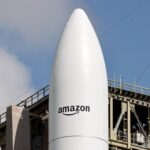SpaceX successfully returned its Dragon spacecraft to flight Friday and landed the first stage of its Falcon 9 rocket almost on target on a barge about 200 miles offshore.
Flying for the first time since a launch failure June, the Dragon and its nearly 7,000 pounds of cargo are headed for a Sunday morning rendezvous with the International Space Station.
The booster landing — not exactly in the center of the platform but enough to keep the equipment from getting wet in the Atlantic Ocean — bolsters SpaceX’s confidence that it can regularly recover rockets that could be flown again, lowering launch costs.
The experiment was SpaceX’s first successful ocean landing.
SpaceX dramatically landed its first booster on shore in December at Cape Canaveral, an event the Chief Executive Elon Musk referred to as a “revolutionary moment” in rocket flight. At least four previous attempts to land on “drone ships” at sea came close but resulted in crashes.
After Friday’s landing on the “drone” ship that SpaceX named “Of Course I Still Love You,” employees gathered at SpaceX headquarters in Hawthorne, Calif., erupted in cheers and chanted “USA!” SpaceX has planned to save its first recovered booster for posterity, so the one that landed Friday potentially could be the first to be re-used.

However, it remains to be seen what condition the rocket stage is in. It will return to Port Canaveral for evaluation, possibly this weekend.
Meanwhile, the Dragon is positioned to return to the space station for the first time in a year.
Packed in its trunk is a prototype Bigelow Aerospace module that may be a precursor to private space stations and deep-space habitats. The Bigelow Expandable Activity Module, or BEAM, will be attached to a station port and expanded to nearly four times its packed volume.
“It is the future,” said Kirk Shireman, head of NASA’s space station program. “Humans will be using these kinds of modules as we move further and further off the planet, and actually as we inhabit low Earth orbit.”
It will stay on the station for two years while sensors measure temperatures, radiation levels and debris impacts. Astronauts will enter the empty module to help outfit it and inspect it from time to time.
Made of layers of soft, reinforced materials around a metal core, the module builds upon technology NASA started developing in the 1990s as a potential space station crew quarters, before cancelling the TransHab program.
Once referred to as “inflatable,” the habitats are now called “expandable” to convey something more structured and less fragile.
“Inflatables makes you think of things like balloons,” said Jason Crusan, director, NASA’s Advanced Exploration Systems Division. “An expandable structure is more like a tent. In a packed configuration, it fits neatly in your car and your backpack. When you go to a site and you set it up, you can open the windows, you can get in it and get out of it, it keeps its structure at that point.”
If you do imagine a balloon, think of one wrapped in a Kevlar-like vest, able to withstand high-speed strikes by space debris even better than metal hulls, said Robert Bigelow, the president of Bigelow Aerospace and owner of the Budget Suites of America hotel chain.
“It’s so incredibly strong, it will maintain its shape,” he said.
The technology makes it possible to fit a large living and working area inside a rocket’s nose cone, saving on space and possibly weight, without needing something like the space shuttle that launched U.S. modules to the space station.
Also on board the Dragon are 20 mice that are part of pharmaceutical company Eli Lilly’s study of muscle wasting, which occurs more rapidly in microgravity.
Space station astronauts Jeff Williams and Tim Peake plan to snare the Dragon with the orbiting laboratory’s 58-foot robotic arm around 7 a.m. ET Sunday.
SpaceX is planning its next launch, a commercial communications satellite, before the end of April from here.
Author : James Dean (@flatoday_jdean)
Via: USA Today
Discover more from TechBooky
Subscribe to get the latest posts sent to your email.







